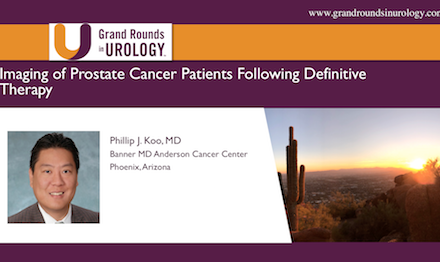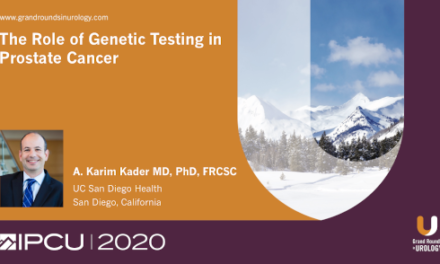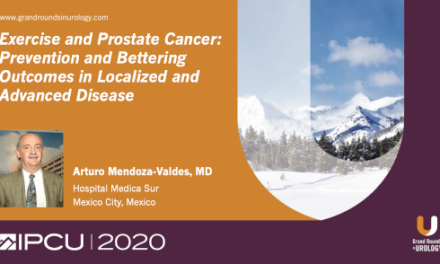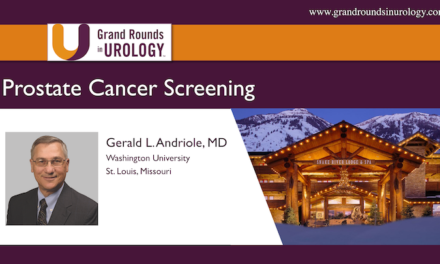Dr. Arturo Mendoza-Valdes spoke at the 25th International Prostate Cancer Update on Friday, January 23, 2015 on “The History of Intermittent Therapy.”
Presentation
Keywords: intermittent therapy, european clinical guidelines, androgenic deprivation, prostate cancer
How to cite: Mendoza-Valdes, Arturo. “The History of Intermittent Therapy” Grand Rounds in Urology. April 6, 2015. Accessed Nov 2024. https://dev.grandroundsinurology.com/prostate-cancer-arturo-mendoza-valdes-intermittent-therapy/.
Transcript
The History of Intermittent Therapy
We all know all the advantages of androgenic deprivation, apoptosis induction; 80% symptomatic and objective response; most patients have a PSA decrease; but we all know there’s always progression; and although it’s controversial for the recent improved survival, there are a few cases especially with low burden that really improve their survival.
Nevertheless, nothing in life is for free and there are many disadvantages. There’s 50% recurrence in two years; there are main side effects; the cost; and after all we don’t know whether it really improves survival.
The side effects are due to pharmacological or surgical castration, or due to antiandrogens. The side effects of pharmacological or surgical castration have been outlined previously in the previous talk besides the ones that you can see here, there are other new ones that Dr. Garnick just showed us.
There are also some side effects due to the antiandrogens such as hot flashes, diarrhea, nausea and vomiting, nipple pain, gynecomastia.
Because of that, we have to talk about intermittent androgenic deprivation which means that you start androgenic deprivation until you get the PSA down to zero, and then when it starts rising again, you restart it and that can happen several times over the time.
The rationale for this is LD androgenic ablation superior to the late therapy androgenic deprivation is not curative, it’s palliative, and we have to think about quality of life is the main objective in these patients.
If tumor cells surviving androgen withdrawal are forced into a normal pathway of differentiation by androgen replacement, then apoptotic potential might be restored and progression to androgen independence delayed. Now as we know there are many other mechanisms that were known when androgenic intermittent therapy was started.
And finally there are several advantages of intermittency which is having the same benefits of androgenic deprivation, less side effects, increases androgenic dependence–that was in theory–and definitely less cost.
The clinical experience was started by Laurence Klotz in 1986, and no wonder he was awarded the Queen’s Jubilee Medal for meritorious public service in 2013 at the University of Toronto Lister Prize and the SUO Medal last year. But besides that he also directs a rock band that he founded and it’s called The Void.
Here is the first publication of Laurence precisely with 19 patients during 30 months and 12 out of 19 recurred at 8 months and all of them responded when treatment was restarted. Sexual potency 9 out of 10, although all of them had a better quality of life.
After that there have been lots of new studies all over the world regarding this approach. Here you can see the problem is that there are a great variety of patients that were included in all these works, and the follow-up is also very valuable. But there is something very clear that most patients in most studies are off therapy almost half of the time which if you think about the cost and about quality of life, that’s very important.
In the initial clinical experience there’s no doubt about the sexual potency recovered although we know that there is about 20% of the patients who never recover it, especially those with more advanced age, it’s less likely that they will recover potency. There’s no doubt there a decreased cost, and there are less side effects, and that altogether turns into a better quality of life.
There are other advantages such as has been shown by Higano were also there is less osteoporosis in patients that are submitted to intermittent therapy, so this is another advantage of intermittent therapy.
But nevertheless, there are many challenges and drawbacks of this therapy. For example, there is no doubt about the improvement of quality of life and is less.
But there are several unanswered questions. Which are the right candidates? When should we start treatment? When should we start it? How long should initial androgen deprivation last? Which is the best combination? Whether monotherapy or total androgenic deprivation?
Here we can see that just as you can see in all these reports there’s no consensus but who are the right candidates. Here you can see there are a lot of different criteria for including patients for intermittency. What the European clinical guidelines said last year was that the best candidates for intermittent have still not been completely defined, but are probably patients with locally advanced or relapsing disease.
There’s no consensus here and there’s no consensus anywhere.
And I can show it to you in my next slide, there are many different criteria. There are almost as many different criteria as there are studies. Here you can see lots of them.
What do the European guidelines say? Well, either a clinical progression or a PSA value above a predetermined, empirically fixed threshold. Most of the studies restart when PSA gets up to 4 to 10 ng/ml in non-metastatic situations or 10 to 15 ng/ml in metastatic patients. There’s no consensus which is the best.
Once again, just as there is a great heterogeneous answer in the audience, that’s the same thing that happens in all the studies that you can see.
So what the European Clinical Guidelines say is between six and nine months, so we are at the end of the same point.
Which is the best combination? Well, most authors talk about complete androgenic deprivation. It could be with LHRH agonist with any of the different antiandrogens, but it seems that most authors use combination of total androgenic deprivation.
But here, you can see there is also a wide variety. And what the European Clinical Guidelines say is, only drugs leading to castration. The interesting thing is we do not know what will happen if we include in these androgenic intermittency abiraterone, orteronel, enzalutamide, antagonists, and others. That’s something very interesting that we will find in the future.
But the most important questions that have never been answered are does this approach improve survival? Retract progression? Or does it delay hormone?
In this review published by Abrahamson in 2010, what he sustains is that even though there is no improvement of survival with this approach, he thinks that the advantage of quality of life overcomes the slight difference in survival, which in this study published by Hussain in New England Journal of Medicine 2013 which was previously presented at ASCO two years ago, in this great study they showed non-inferiority of intermittent androgenic deprivation therapy compared to continuous with respect to survival among patients with hormone sensitive prostate cancer was statistically inconclusive. However, nearly the entire confidence interval favors continuous androgenic deprivation. Intermittent androgenic deprivation may compromise survival, and this is something, this is the first time that in a big study like this one they showed this. The numbers of grade 3 or 4 adverse events were remarkably similar in the two groups, 30.4% in the intermittent and 32.7% in the continuous therapy group.
But that same year, another literature review presented by, published by Niraula and in six of the nine studies reported on quality of life results with well validated questionnaires, patients on intermittent had better scores on some domains of quality of life and less treatment-related adverse events such as sexual dysfunction, hot flashes, and impaired physical function, but there was significant superiority of overall quality of life for men receiving intermittent therapy in only one study. Regarding that cost, obviously there is a substantial cost saving with the use of intermittent. It’s almost half the price of continuous, and there is fair evidence to recommend the substitution of continuous androgenic deprivation by intermittent to treat men with relapsing locally advanced or metastatic prostate cancer because there is a similar survival using less therapy; substantial decrease in exposure to androgen deprivation resulting in less cost, inconvenience and potential toxicity; premature to recommended intermittent androgenic deprivation for men with severe symptoms, or visceral metastases. This means that people with a high burden of disease probably is not the right patient to use intermittent. But in this review, they conclude that intermittent is a good therapy.
What do the European Guidelines say? Continuous treatment provides a specific survival difference compared to intermittent, the survival difference is completely counterbalanced by the increased specific toxicity of continuous androgenic deprivation therapy, which therefore results in a lack of difference in overall survival, the increasing of which remains the main objective.
Intermittent androgen deprivation has not been shown to be associated with prolonged hormone-sensitive status or overall survival increase.
What’s in the future? In the future, we have to answer the unanswered questions such as to define who are the ideal candidates, the length of initial treatment. We have to uniform criteria to improve survival, time to recurrence and quality of life. We have to find out and observe the effect of bone loss. Which is the best drug for combination?
But it’s another option for advanced prostate cancer, improves quality of life, fewer side effects, enables patients to perform sexual life, less cost, and the challenge is to solve all the questions that I have been addressing.
It is not a standard, but a good option in many cases to define who are the optimal candidates. There is still a lot more to improve and to investigate.
References
References
Abrahamsson PA. Potential benefits of intermittent androgen suppression therapy in the treatment of prostate cancer: a systematic review of the literature. Eur Urol. 2010 Jan;57(1):49-59.
http://www.ncbi.nlm.nih.gov/pubmed/19683858
Higano C, Shields A, Wood N, et al. Bone mineral density in patients with prostate cancer without bone metastases treated with intermittent androgen suppression. Urology. 2004 Dec;64(6):1182-6.
http://www.ncbi.nlm.nih.gov/pubmed/15596194
Klotz LH, Herr HW, Morse MJ, et al. Intermittent endocrine therapy for advanced prostate cancer. Cancer. 1986 Dec 1;58(11):2546-50.
http://www.ncbi.nlm.nih.gov/pubmed/2429759
ABOUT THE AUTHOR
Arturo Mendoza-Valdés, MD, attended medical school at the National Autonomous University of Mexico (UNAM) in Mexico City. He completed a residency in urology at the Instituto Nacional de Nutrición “Salvador Zubirán” (INNSZ), also in Mexico City. Dr. Mendoza-Valdés has served as a staff member (1987-2000) and Chief of the Urology Department (1988-1996) at the National Cancer Institute of Mexico. He is currently a Professor in the Urology Residency Program at INNSZ.
Dr. Mendoza-Valdés is a former President of the Mexican Urological Association, as well as a former President of the SCS-AUA. In 1998, he and other Mexican urologists founded the Mexican Urologic Oncology Association, and he serves as its President and Scientific Committee Chairman to this day.
Dr. Mendoza-Valdés has organized 24 International Symposiums of Urologic Oncology in Mexico. He was a member of the scientific committee of the SIU from 1999 to 2013. He is a Co-Founder of the WUOF (World Urologic Oncology Federation) and has been a member of its steering committee since 2004. He has been a member of the Clinical Practice Guidelines of the AUA (2010-2013), and a member of the Urologic Diagnostic and Therapeutic Imaging Committee (2010 to 2016). Dr. Mendoza-Valdés has also been a member of the SUO (Society of Urologic Oncology) since 2013. In 2012, he became Honorary Member of the EAU. He has participated in 3 ICUD panels on prostate cancer and one on penile cancer. He is a member of the editorial board of the CJU. Dr. Mendoza-Valdés has served as faculty at IPCU many times.





